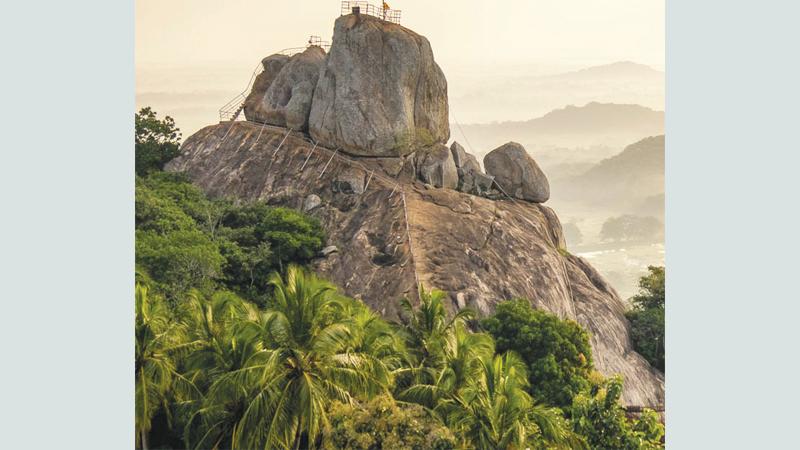
As Poson Poya draws near our attention is drawn to Mihintale for it was here that the Arahath Mahinda met King Devanampiyatissa, preached the Dhamma to him and converted the King and his followers to Buddhism. Mihintale has many sites of religious and historical importance and today the Junior Observer brings a pictorial feature on some of them.
Steps
 |
| Maha stupa |
To reach Mihintale Rock you have to climb a stairway of wide, stone steps. There are 1,840 steps leading to the Middle Terrace and from here another series of steps lead to the Ambasthala Stupa on the upper terrace. Ambasthala Stupa (Chaithya)
The Ambasthala Stupa is on the plain close to the mountain peak on the upper terrace of the Mihintale Rock.It is also known as the ‘Sela Chaithya. It is also said that this is the exact spot where Arahath Mahinda met King Devanampiyatissa and preached the Dhamma to him on a Poson Poya Day
The Ambasthala Stupa is surrounded by stone pillars. It is a small stupa and is believed to have been built by King Mahadathtika Mahanaga. From the side of the stupa flight of steps lead to a large Buddha statue. The ruins indicate that a house had been built encircling the Stupa. The relics of Arahath Mahinda is said to be enshrined here.
This stupa was built by King Devanampiyatiss.
 |
| The Hospital |
Kantaka Chaithya
This is circular stupa at the end of the first flight steps to Mihintale. From the first landing of the steps leading to Mihintale a flight of 100 side steps leads to the Kantaka Chaithya. It is supposed to be one of the oldest stupas at Mihintale and the original height is believed to have been more than 30 metres in height. Now, it is 12 metres in height and 30 metres at the base. A Brahmi inscription states tha the funding for the Kantaka Chaithya came from a water tank nearby. There are four flower altars at the main points of thechaithya. There are aslo sculptures of dwarfs and geese. It is not known as to who built the Kantaka Chaithya but King Lajjitissa is supposed to have enlarged it in the first century BC.
Mihindu Guhawa (Cave)
For much of the nearly 48 years that Arahath Mahinda spent in Sri Lanka he resided at the Mihindu Guhawa at Mihintale. His seat is carved into the rock. Much of the rainy seasons was spent here by Arahath Mahinda. The Mihindu Guhawa was offered to the Arahath Mahinda by King Devanampiyatissa.
Of the sixty-eight caves offered to the Sangha at that time sixty-two have been found now. The Mihindu Guhawa is is situated on a hill slope near the Ambasthala Chetiya. The cave is formed by two separate rock boulders so there is an opening on the both sides of the cave. The cave bed is chiseled out to have a flat surface. It is approximately a little over 2 mts x 1 mts in length and breadth. bed space. Arahath Mahinda lived for 80 years at Mihintale.
Kalu Diya Pokuna
Mihintale’s Kaludiya Pokuna is a monastic complex surrounding a water pond. It is 200 feet in length and 70 feet in width and is situated away from the main complex along the main road.This is an artificial pond where the water is collected from the surroundings during the rainy season.
The name Kalu Diya Pokuna or the Black Water Pond is said to have been given due to the dark colour of the reflections of the rocks and boulders and the trees appearing in the water. History says that the bhikkhus had used this complex for meditation. There is an inscription which has Brahmi scripts belonging to the B.C era.
Sinha Pokuna
 |
| Mihintale ancient stairway |
Amid the ruins of the monastic buildings near the Assembly hall the Sinha Pokuna or the Lion’s Pond is located. It is an open air bath. This is near the middle terrace close to vehicle park. Water is collected to a rectangular shaped tank from a water rail and comes out of the mouth of a sculptured granite Lion
The life size Lion figure is carved out of the rock in which a part of the water tank also is built.
The water for this pond is taken through a channel from the Naga Pokuna.
This water bath is believed to be used by the bhikkhus who lived in many caves in the surrounding areas.
The Hospital
The ancient hospital complex at Mihintale is thought to be the oldest in the world by some experts. Heinz E Müller-Dietz in his Historia Hospitalium 1975 states that the Mihintale Hospital may be the oldest in the world. The ruins of the hospital are at the foot of the Mihintale mountain.
 |
| Sinhapokuna |
There is also a beheth oruwa or a medicinal trough where patients were immersed in medicinal baths.
The ruins which can be seen today are believed to be of a hospital built King Sena II (853-887 AD). But historians and archaeologists say there was a hospital at Mihintale long before this this hospital was built. The inner Chamber of the hospital is built around a Buddha Shrine and around it are the rooms for the patients.
The outer court is on the southern side of the building and contains the hot water and steam bath, a medicine store and a grinding stone to grind medicines among other thinga.
Maha Stupa
The first century Maha Stupa is a large stupa at the summit of Mihintale built by King Mahadathtika Mahanaga.
Sources. Wikipedia , Lonely Planet, Lakpura, Internet
 |
| Ambasthala stupa |
 |
| Kaludiya pokuna |
 |
| Arahath Mahinda’s Cave |
